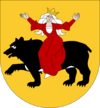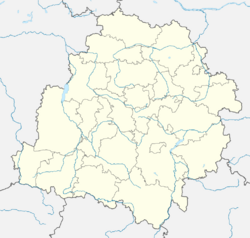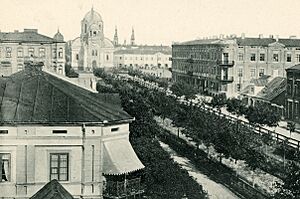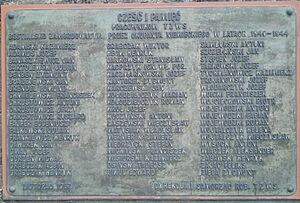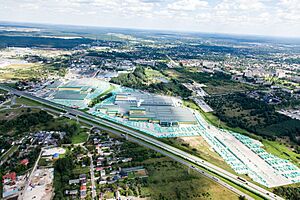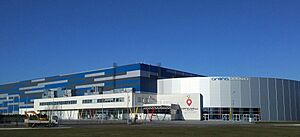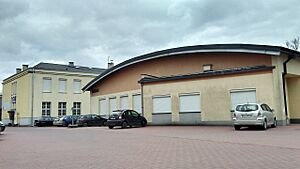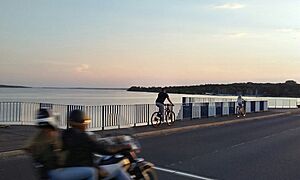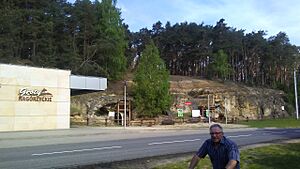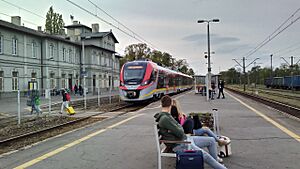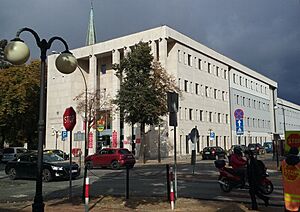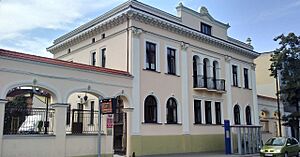Tomaszów Mazowiecki facts for kids
Quick facts for kids
Tomaszów Mazowiecki
|
|||
|---|---|---|---|
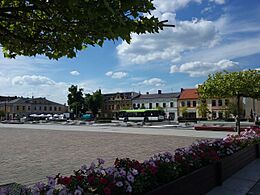
Plac Kościuszki, main square of Tomaszów Mazowiecki
|
|||
|
|||
| Country | |||
| Voivodeship | Łódź | ||
| County | Tomaszów Mazowiecki County | ||
| Gmina | Tomaszów Mazowiecki (urban gmina) | ||
| Established | 18th century | ||
| City rights | 1830 | ||
| Area | |||
| • Total | 41.3 km2 (15.9 sq mi) | ||
| Population
(31 December 2021)
|
|||
| • Total | 60,529 |
||
| Time zone | UTC+1 (CET) | ||
| • Summer (DST) | UTC+2 (CEST) | ||
| Postal code |
97-200
|
||
| Area code(s) | +48 44 | ||
| Car plates | ETM | ||
| Climate | Dfb | ||
| Highways | |||
| National roads | |||
| Voivodeship roads | |||
| Website | http://www.tomaszow-maz.eu | ||
Tomaszów Mazowiecki is a city in central Poland. In 2021, about 60,529 people lived there. It is the fourth largest city in the Łódź Voivodeship region. It is also one of the few cities in Poland with free public transport.
Tomaszów Mazowiecki is home to the first and only all-year speed skating track in Poland. This track, called Ice Arena Tomaszów Mazowiecki, has even hosted World Championships. Every autumn, the city also hosts the international Love Polish Jazz festival.
Contents
- Where is Tomaszów Mazowiecki Located?
- A Quick Look at Tomaszów Mazowiecki History
- Tomaszów Mazowiecki Geography
- What is the Economy of Tomaszów Mazowiecki Like?
- Sports in Tomaszów Mazowiecki
- Education in Tomaszów Mazowiecki
- Interesting Places to Visit
- How to Get Around Tomaszów Mazowiecki
- Sister Cities of Tomaszów Mazowiecki
- Polish Armed Forces in Tomaszów Mazowiecki
- Famous People from Tomaszów Mazowiecki
- Images for kids
- See also
Where is Tomaszów Mazowiecki Located?
Tomaszów is in the Łódź Voivodeship region of Poland. This has been its location since 1999. Before that, from 1975 to 1998, it was part of the Piotrków Voivodeship.
The city covers an area of about 41.3 square kilometers. It sits on the banks of three rivers: the Pilica, Wolbórka, and Czarna Bielina. It is also close to the Sulejow Reservoir and the edge of the Puszcza Spalska forest.
A Quick Look at Tomaszów Mazowiecki History
Tomaszów Mazowiecki was started in 1788 by Count Tomasz Adam Ostrowski. He founded the settlement after iron ore was found there. He invited the first miners and metalworkers to come and live in the area.
In 1793, the area became part of Prussia. Later, in 1807, it was returned to Polish control. In 1815, it became part of the Russian-controlled part of Poland. The metal industry grew a lot around 1820.
Tomaszów officially became a city in 1830. This happened during the November Uprising, when Poles fought against the Russian Empire. The first weavers came to Tomaszów from Zgorzelec. A Lutheran church was built in 1823.
Tomaszów Mazowiecki During World War I and II
During World War I, German forces occupied Tomaszów. This caused a lot of hardship for the people living there. Polish people in the town secretly resisted the occupation.
After the war, Poland became independent again on November 11, 1918. Polish people disarmed the German troops, who then left the town. The first Polish military unit was formed in Tomaszów in mid-November 1918.
On September 1, 1939, World War II began with the German invasion of Poland. German planes bombed Tomaszów twice on that day, killing seven people. More bombings happened in the following days, making many people leave.
On September 6, a battle took place between Polish and German forces in Tomaszów. German soldiers entered the town on September 7. They took many things, burned houses, and killed some residents.
The Germans created a special office to send local Poles to forced labor. They also destroyed the city's synagogues. Before Polish Independence Day in 1939, German police arrested about 300 Poles. These included priests, teachers, doctors, and workers. Most were later released, but some were sent to prison camps.
More arrests of Poles happened in 1940. Many people were sent to concentration camps like Sachsenhausen and Ravensbrück. Some were killed on the spot. A ghetto was created in December 1940 to imprison about 16,500 Polish Jews. Life in the ghetto was very hard, with little food and many diseases.
In December 1942, about 15,000 Jews were sent by train to the Treblinka extermination camp. Only about 200 Jews from Tomaszów survived World War II. The Germans continued to kill Poles and set up a prison and forced labor camp for young Poles. In 1944, even 12-year-old Polish children were forced to build defenses.
After the Warsaw Uprising in 1944, thousands of people from Warsaw were sent to Tomaszów Mazowiecki. These were mostly older people, sick people, and women with children. By November 1944, about 30,000 Poles from Warsaw were staying in Tomaszów and nearby areas.
Tomaszów Mazowiecki Geography
In 2006, Tomaszów had an area of 41.3 square kilometers. About 45% of the land is used for farming. Forests cover 13% of the area. The city itself takes up about 4% of the land.
In the southern part of the town, near the Pilica river, there is a special natural spring. This spring has water with calcium salts. It is protected in the Niebieskie Źródła Nature Reserve. The reserve's name, Niebieskie Źródła, means Blue Springs. This is because the water absorbs red light, making the spring look blue and green.
What is the Climate Like in Tomaszów Mazowiecki?
Tomaszów Mazowiecki has a humid continental climate. This means it has warm summers and cold winters.
| Climate data for Tomaszów Mazowiecki | |||||||||||||
|---|---|---|---|---|---|---|---|---|---|---|---|---|---|
| Month | Jan | Feb | Mar | Apr | May | Jun | Jul | Aug | Sep | Oct | Nov | Dec | Year |
| Mean daily maximum °C (°F) | 0.3 (32.5) |
2.1 (35.8) |
7.1 (44.8) |
13.8 (56.8) |
18.7 (65.7) |
22.0 (71.6) |
24.0 (75.2) |
23.7 (74.7) |
18.8 (65.8) |
12.8 (55.0) |
7.3 (45.1) |
2.5 (36.5) |
12.8 (55.0) |
| Daily mean °C (°F) | −2.0 (28.4) |
−0.9 (30.4) |
3.1 (37.6) |
9.1 (48.4) |
14.2 (57.6) |
17.7 (63.9) |
19.7 (67.5) |
19.3 (66.7) |
14.5 (58.1) |
9.3 (48.7) |
4.7 (40.5) |
0.4 (32.7) |
9.1 (48.4) |
| Mean daily minimum °C (°F) | −4.5 (23.9) |
−4.0 (24.8) |
−1.0 (30.2) |
3.8 (38.8) |
9.0 (48.2) |
12.6 (54.7) |
15.0 (59.0) |
14.5 (58.1) |
10.4 (50.7) |
6.0 (42.8) |
2.2 (36.0) |
−1.8 (28.8) |
5.2 (41.3) |
| Average precipitation mm (inches) | 45 (1.8) |
41 (1.6) |
49 (1.9) |
50 (2.0) |
73 (2.9) |
69 (2.7) |
92 (3.6) |
64 (2.5) |
61 (2.4) |
47 (1.9) |
45 (1.8) |
46 (1.8) |
682 (26.9) |
| Source: https://en.climate-data.org/europe/poland/łodz-voivodeship/tomaszow-mazowiecki-10350/ | |||||||||||||
What is the Economy of Tomaszów Mazowiecki Like?
From the mid-1800s to the 1990s, Tomaszów was a big center for the textile industry. It was the second largest producer of wool clothing in Poland and the Russian Empire. In the 1900s, thanks to the Artificial Silk Factory, it became a major European center for making fibers and plastics.
Today, Tomaszów Mazowiecki is part of the Łódź Special Economic Zone. This is one of 14 special economic zones in Poland. The city has many different industries. These include ceramics, construction, chemicals, plastics, electrical machines, upholstery, food, and logistics.
Major Industries in Tomaszów Mazowiecki
- Materials Industry: Companies like Ceramika Paradyż make ceramic tiles. Sacmi makes machines for producing ceramic tiles. Wagran, located where the old Artificial Silk Company used to be, makes granite sinks.
- Construction Sector: Balex Metal makes high-quality steel construction parts. Ezbud-Budownictwo builds homes and offices. They also sell and manage properties. This company has built many housing areas in Tomaszów and Łódź since 1989.
- Chemical Industry: Sicher Bautechnik makes chemicals for construction. EcoHydroCarbon processes polymer waste. Toma is a company that processes plastics.
- Equipment Manufacturers: Markom makes welding and transport equipment. Glass Product makes systems for automatic fertilization and moving raw materials.
- Carpets and Upholstery: The Japanese car company Toyota has a factory in Tomaszów. They make upholstery for their fancy cars. Weltom, a company that makes carpets and rugs, also has a factory here. It was started in 1848 by Eleonora and Jan Roland. Their son, Edward, grew the business from a small workshop. By 1905, it had 130 weavers. The company became well-known across the Russian Empire. Today, Weltom also makes upholstery and coconut wipers. A whole area of the city, Rolandówka, is named after the company's founders.
- Food Industry: PepsiCo makes Cheetos crisps in Tomaszów. Chipita makes croissants. Roldrob (Drosed) makes poultry products for places like KFC. Las Vegas makes energy drinks. This group also owns the "Bulwary" shopping center in the city.
- Logistics and Services: FM Logistic provides services for big stores like Carrefour and Makro Cash and Carry. Syntom is a company that recycles materials.
Sports in Tomaszów Mazowiecki
The city has two main sports clubs. Lechia Tomaszów Mazowiecki has football and volleyball teams. Pilica Tomaszów Mazowiecki has speed skating and bowling sections.
The Ice Arena Tomaszów Mazowiecki is a very important sports place. It hosts big international speed skating competitions, including ISU Speed Skating World Cups. It is also used for ice hockey games.
Education in Tomaszów Mazowiecki
Tomaszów Mazowiecki has seven high schools. It also has branches of well-known universities, such as:
- A branch of the University of Łódź
- A branch of the Pułaski University of Technology and Humanities from Radom
- A branch of Wyższa Szkoła Biznesu i Przedsiębiorczości from Ostrowiec
Interesting Places to Visit
The city has the first year-round ice skating rink in Poland. It is used for speed skating, figure skating, ice hockey, short track, and roller skating. It is located near the Pilica River.
During World War II, the German army built several secret bunkers near Tomaszów Mazowiecki. They started building two large air-raid shelters in early 1940.
The Konewka Bunkers are now a tourist attraction. They are a group of concrete buildings hidden in the woods. One huge bunker is 380 meters long. It was built to protect an entire train from air raids. These shelters were used to unload military supplies.
Sulejowski Reservoir
The Sulejow Lake is a large reservoir. It was built between 1969 and 1973. Its purpose was to provide fresh drinking water for the cities of Łódź and Tomaszów Mazowiecki. The reservoir is a popular spot for water sports, like windsurfing, canoeing, and sailing.
Nagórzyckie Grottoes
In the south of the town, there is an old quartz sand mine from the 1700s. These are called The Nagórzyckie Grottoes (Polish: Groty Nagórzyckie). Today, you can explore them as an underground tourist route. There is a building at the entrance with tickets and restrooms. You can get there by city bus or by an illuminated bicycle path.
How to Get Around Tomaszów Mazowiecki
Public bus transportation started in Tomaszów in 1929. Since 2018, public transport in the city has been free.
You can travel directly by train from Tomaszów to cities like Kraków, Łodź, Poznań, Gdynia, and Szczecin.
Several main roads meet in the city:
- Invalid type: S goes towards Suwałki – Warsaw – Tomaszów Mazowiecki – Wrocław – Kudowa-Zdrój
- Invalid type: DK goes towards Kozienice – Dęblin – Kock
- Invalid type: DW goes towards Łódź – Tomaszów Mazowiecki – Januszewice near Opoczno
Sister Cities of Tomaszów Mazowiecki
Tomaszów Mazowiecki is twinned with these cities:
 Ivano-Frankivsk, Ukraine
Ivano-Frankivsk, Ukraine Linares, Spain
Linares, Spain Mionica, Serbia
Mionica, Serbia Polonezköy (Beykoz), Turkey
Polonezköy (Beykoz), Turkey
Polish Armed Forces in Tomaszów Mazowiecki
The 25th Air Cavalry Brigade is based in Tomaszów Mazowiecki. Their main offices and barracks are in the town. The Polish Armed Forces have been in Tomaszów Mazowiecki since 1918. There is also an airport for the Brigade, called Tomaszów Mazowiecki Airport. It is located near the city's north-eastern edge, by Expressway S8.
Famous People from Tomaszów Mazowiecki
Many notable people come from Tomaszów Mazowiecki, including:
- Karolina Bosiek (born 2000), a Polish speed skater
- Tadeusz Chmielewski (1927–2016), a Polish film director and writer
- Izabela Kuna (born 1970), a Polish actress
- Oskar Lange (1904–1965), a Polish economist
- Wanda Panfil-González (born 1959), a Polish long-distance runner
- Jaromir Radke (born 1969), a Polish speed skater
- Michael Sela (1924–2022), an Israeli immunologist
Images for kids
-
A complex of special schools.
-
One of the stadiums for the city's football club "Lechia 1923".
See also
 In Spanish: Tomaszów Mazowiecki para niños
In Spanish: Tomaszów Mazowiecki para niños



